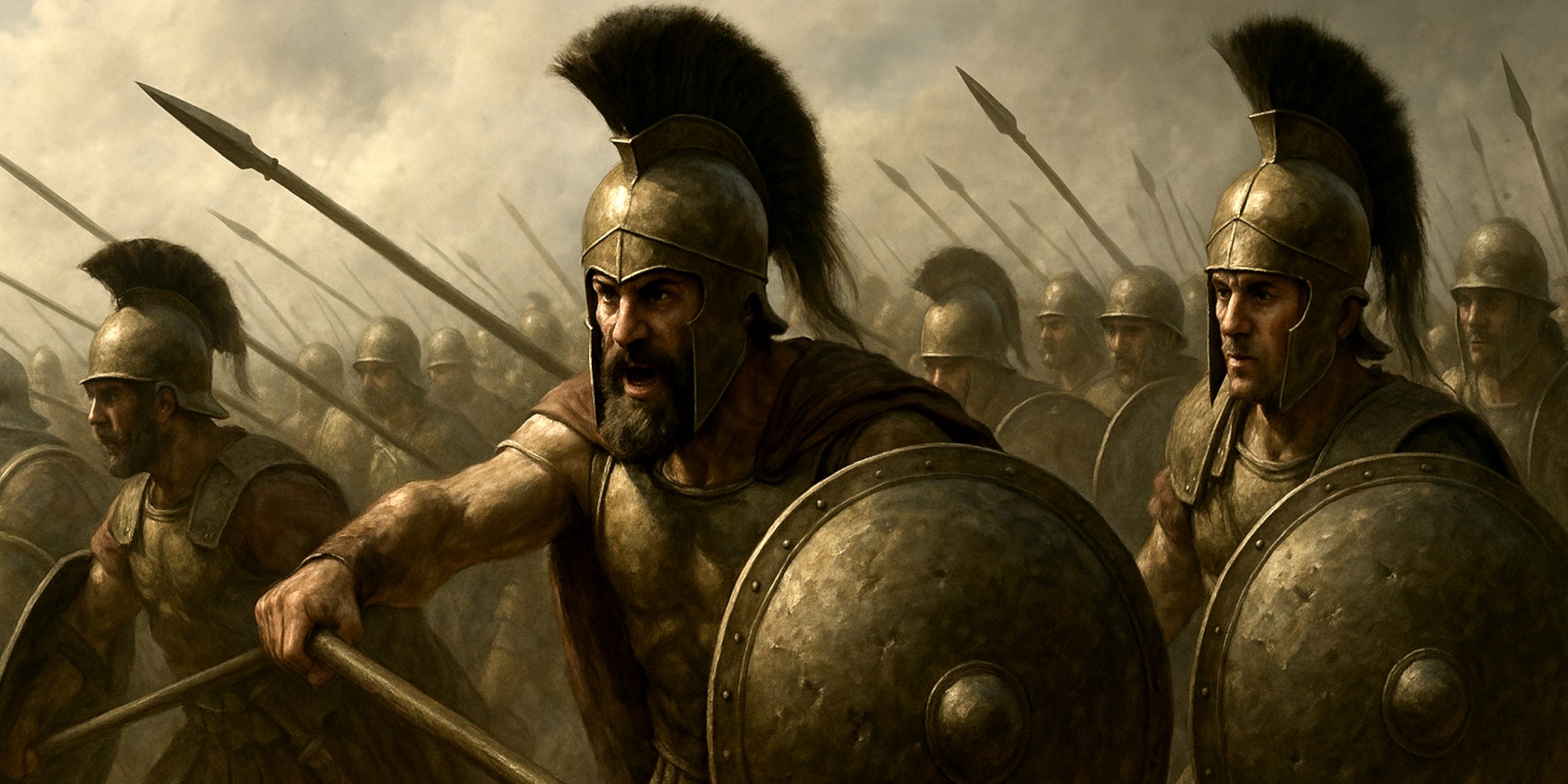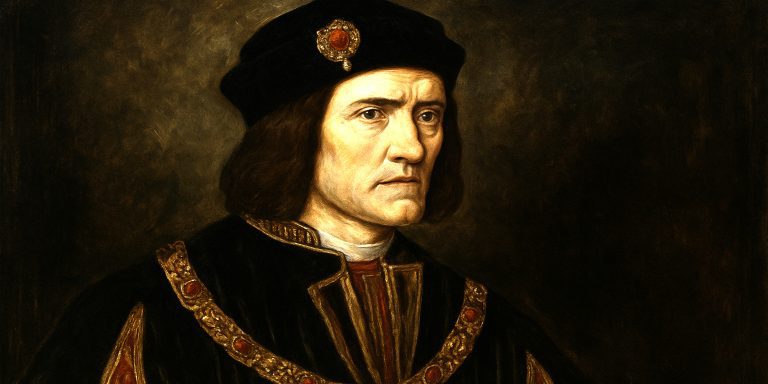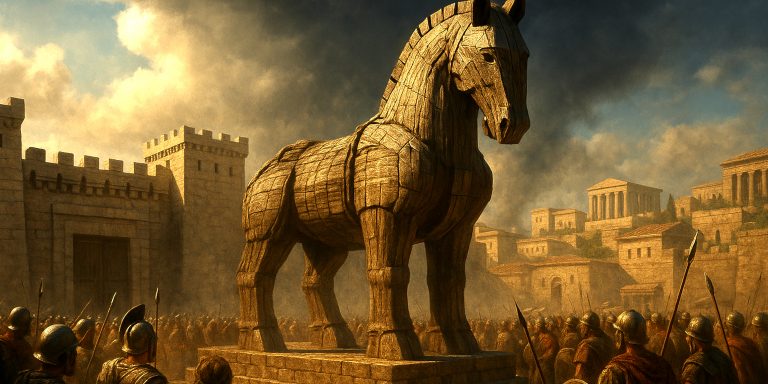
Ancient Greece was shaped not just by philosophy and art but by conflict. From the shores of Asia Minor to the mountains of Boeotia, Greek city-states and kingdoms fought for dominance, independence, and legacy. The battles listed below had lasting impacts,militarily, politically, and culturally. They influenced alliances, reshaped borders, and in many cases, helped define Western military tradition. The following list ranks the 25 most consequential battles involving Ancient Greeks, from least to most impactful.
25. Battle of Amphipolis (422 BCE)
Summary: A decisive Spartan victory during the Peloponnesian War that claimed the lives of both generals: Brasidas and the Athenian Cleon.
Commanders: Brasidas (Sparta), Cleon (Athens)
Troops: Sparta c. 2,000; Athens c. 2,000
Weapons: Dory spears, hoplite shields, xiphos, bows
Outcome: Spartan victory
Legacy: Removed two of the most aggressive war leaders, paving the way for the Peace of Nicias.
24. Battle of Delium (424 BCE)
Summary: Athenian forces attempted to occupy a Boeotian sanctuary but were repelled by Theban cavalry.
Commanders: Hippocrates (Athens), Pagondas (Thebes)
Troops: Athens c. 7,000; Thebes c. 7,000
Weapons: Hoplite panoply, cavalry javelins
Outcome: Theban victory
Legacy: Showed the rising tactical innovations of Thebes, including early use of reserve units.
23. Battle of Pydna (148 BCE)
Summary: Final Macedonian resistance against Rome. The Roman legions crushed Andriscus’ forces.
Commanders: Quintus Caecilius Metellus (Rome), Andriscus (Macedon)
Troops: Rome c. 25,000; Macedon c. 20,000
Weapons: Roman gladii, Macedonian sarissas
Outcome: Roman victory
Legacy: End of Macedonian independence. Greece absorbed into the Roman world.
22. Battle of Notium (406 BCE)
Summary: Lysander lured the Athenian navy into a trap near Ephesus.
Commanders: Lysander (Sparta), Antiochus (Athens)
Troops: Sparta c. 90 triremes; Athens c. 80
Weapons: Triremes, boarding spears, archers
Outcome: Spartan victory
Legacy: Boosted Lysander’s standing and began Sparta’s naval ascendancy.
21. Battle of Himera (480 BCE)
Summary: A combined Syracusan and Akragan force repelled a Carthaginian invasion in Sicily.
Commanders: Gelon (Syracuse), Hamilcar (Carthage)
Troops: Greeks c. 25,000; Carthage c. 50,000
Weapons: Hoplite arms, cavalry, chariots
Outcome: Greek victory
Legacy: Secured Greek Sicily and checked Carthaginian expansion for decades.
20. Battle of Aegospotami (405 BCE)
Summary: Sparta’s fleet destroyed the last Athenian navy, effectively ending the Peloponnesian War.
Commanders: Lysander (Sparta), Conon (Athens)
Troops: Sparta c. 200 ships; Athens c. 180
Weapons: Triremes, marines with spears and bows
Outcome: Decisive Spartan victory
Legacy: Athens surrendered soon after; Sparta imposed oligarchic rule in many cities.
19. Battle of Chaeronea (338 BCE)
Summary: Philip II crushed the combined forces of Athens and Thebes, asserting Macedonian dominance.
Commanders: Philip II and Alexander (Macedon); Chares (Athens), Theban Sacred Band
Troops: Macedon c. 30,000; Allies c. 35,000
Weapons: Sarissas, hoplite spears, cavalry sabres
Outcome: Macedonian victory
Legacy: Greek autonomy ended. Paved way for Alexander’s conquests.
18. Battle of Tanagra (457 BCE)
Summary: Athens attempted to break Spartan dominance in central Greece but failed.
Commanders: Myronides (Athens), Nicomedes (Sparta)
Troops: Sparta c. 11,000; Athens c. 14,000
Weapons: Hoplite armour, spears, swords
Outcome: Spartan victory
Legacy: Reinforced Spartan supremacy but exposed its logistical limits.
17. Battle of Crocus Field (c. 353 BCE)
Summary: Philip II of Macedon defeated the Phocians in a major battle during the Third Sacred War.
Commanders: Philip II (Macedon), Onomarchus (Phocians)
Troops: Macedon c. 30,000; Phocians c. 25,000
Weapons: Sarissas, Greek mercenary arms
Outcome: Macedonian victory
Legacy: Secured Philip’s control over central Greece.
16. Battle of Sphacteria (425 BCE)
Summary: Athenian forces captured 292 Spartans, shocking the Greek world.
Commanders: Demosthenes (Athens), Epitadas (Sparta)
Troops: Athens c. 10,000; Sparta c. 400
Weapons: Light missile troops, hoplite arms
Outcome: Athenian victory
Legacy: Undermined the myth of Spartan invincibility.
15. Battle of Oenophyta (457 BCE)
Summary: Athenian forces seized Boeotia, expanding their land empire.
Commanders: Myronides (Athens)
Troops: Athens c. 14,000; Boeotians c. 10,000
Weapons: Standard hoplite kit
Outcome: Athenian victory
Legacy: Brief Athenian control of Boeotia and central Greece.
14. Battle of Thermopylae (480 BCE)
Summary: A small Greek force led by Leonidas delayed the vast Persian army.
Commanders: Leonidas (Sparta), Xerxes I (Persia)
Troops: Greeks c. 7,000; Persians c. 100,000–300,000
Weapons: Hoplite gear, Persian composite bows and cavalry
Outcome: Persian victory
Legacy: Became a symbol of courage and resistance against overwhelming odds.
13. Battle of Corinth (394 BCE)
Summary: Part of the Corinthian War, a bloody stalemate showing hoplite limits.
Commanders: Agesilaus II (Sparta), allied coalition (Thebes, Corinth, Athens)
Troops: Sparta c. 13,000; Allies c. 15,000
Weapons: Hoplite warfare
Outcome: Tactical Spartan victory
Legacy: Diminished Spartan authority and heralded shifting coalitions.
12. Battle of Cynoscephalae (197 BCE)
Summary: Romans defeated Philip V’s phalanx using flexible manipular formations.
Commanders: Titus Quinctius Flamininus (Rome), Philip V (Macedon)
Troops: Rome c. 26,000; Macedon c. 25,000
Weapons: Sarissas vs Roman gladii and pila
Outcome: Roman victory
Legacy: Marked the beginning of Roman supremacy in the Greek world.
11. Battle of Delos (88 BCE)
Summary: A lesser-known but pivotal Roman counterattack during the Mithridatic Wars.
Commanders: Lucius Cornelius Sulla (Rome), Archelaus (Pontus, with Greek mercenaries)
Troops: Rome c. 20,000; Pontic Greeks c. 25,000
Weapons: Gladii, hoplite remnants, siege engines
Outcome: Roman victory
Legacy: Reasserted Roman control over rebellious Greek territories.
10. Battle of Mantinea (418 BCE)
Summary: A major hoplite clash. Sparta reasserted itself against Athens and its allies.
Commanders: Agis II (Sparta), Laches (Athens)
Troops: Sparta c. 9,000; Athens and allies c. 10,000
Weapons: Dory, xiphos, heavy shields
Outcome: Spartan victory
Legacy: Slowed Athenian influence and preserved Spartan prestige.
9. Battle of Lechaeum (391 BCE)
Summary: Light-armed Athenian peltasts routed a Spartan hoplite force.
Commanders: Iphicrates (Athens)
Troops: Athenian light troops c. 600; Spartans c. 600
Weapons: Javelins, short swords
Outcome: Athenian victory
Legacy: Demonstrated the growing importance of light infantry and skirmishers.
8. Battle of Issus (333 BCE)
Summary: Alexander crushed Darius III in a narrow coastal pass.
Commanders: Alexander the Great, Darius III
Troops: Macedon c. 40,000; Persia c. 100,000+
Weapons: Sarissas, xyston, Persian archery
Outcome: Macedonian victory
Legacy: Secured Asia Minor. Darius fled. Alexander began to appear unstoppable.
7. Battle of Granicus (334 BCE)
Summary: Alexander’s first major victory in Asia against Persian satraps.
Commanders: Alexander the Great
Troops: Macedon c. 35,000; Persia c. 40,000
Weapons: Macedonian cavalry, Persian cavalry with javelins
Outcome: Macedonian victory
Legacy: Opened Asia Minor and proved the effectiveness of Macedonian tactics.
6. Battle of Mycale (479 BCE)
Summary: Greeks destroyed the Persian fleet and army camp in Ionia.
Commanders: Leotychidas (Sparta), Xanthippus (Athens), Tigranes (Persia)
Troops: Greeks c. 40,000; Persians c. 60,000
Weapons: Naval arms, hoplite kits, Persian archers
Outcome: Greek victory
Legacy: Marked the final defeat of Persia’s invasion force.
5. Battle of Salamis (480 BCE)
Summary: Athenian-led fleet trapped and crushed the Persian navy in narrow straits.
Commanders: Themistocles (Athens), Xerxes I (Persia)
Troops: Greeks c. 370 ships; Persia c. 600–800
Weapons: Triremes, ramming, boarding
Outcome: Greek victory
Legacy: Turned the tide of the Persian Wars. Persia’s naval strength broken.
4. Battle of Plataea (479 BCE)
Summary: Greek alliance dealt Persia a final land defeat in mainland Greece.
Commanders: Pausanias (Sparta), Mardonius (Persia)
Troops: Greeks c. 80,000; Persia c. 100,000
Weapons: Hoplite arms, Persian cavalry
Outcome: Greek victory
Legacy: Ended Persian ambitions in Greece.
3. Battle of Gaugamela (331 BCE)
Summary: Alexander’s masterpiece. He outmanoeuvred a vastly larger Persian army.
Commanders: Alexander the Great, Darius III
Troops: Macedon c. 47,000; Persia c. 120,000+
Weapons: Combined arms: cavalry, sarissas, archers
Outcome: Macedonian victory
Legacy: Decisive end to the Persian Empire. Alexander crowned King of Asia.
2. Battle of Marathon (490 BCE)
Summary: Athenian hoplites defeated a larger Persian force on home soil.
Commanders: Miltiades (Athens), Datis and Artaphernes (Persia)
Troops: Athens c. 11,000; Persia c. 25,000
Weapons: Hoplite kit vs Persian light infantry
Outcome: Athenian victory
Legacy: First major blow to Persian ambitions in Greece. Proved hoplites’ effectiveness.
1. Battle of Pelusium (525 BCE)
Summary: Not fought between Greeks directly, but heavily involved Ionian mercenaries. Cambyses II defeated Psamtik III, opening Egypt to Persia.
Commanders: Cambyses II (Persia), Psamtik III (Egypt)
Troops: Persia (with Greek mercenaries) c. 50,000; Egypt c. 60,000
Weapons: Greek phalanx arms, Persian archers
Outcome: Persian victory
Legacy: Expanded Persian control to Egypt. Greek mercenaries played a defining role.



